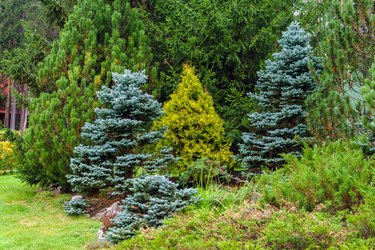
Comparing spruce (Picea spp.) vs. pine (Pinus spp.) vs. fir wood (Abies spp.) helps you decide which wood to use based on your project. Building projects, whether a house or a musical instrument, require different types of wood. No two types of wood are the same, though species within a group may be similar in texture, weight or appearance. Conifer trees, such as pine, spruce and fir, all have similar traits but also different characteristics that make them ideal for use in various projects.
Spruce, Pine and Fir Identification
Video of the Day
Pine, spruce, and fir trees are all evergreen trees. They are identified easily by their needled or scaled leaves and cones with seeds, compared to deciduous trees that have broad leaves and different structures, such as acorns, as seeds instead. Pine trees feature needles that cluster in groups of two, three or five and jet outward from the branches, whereas spruce and fir trees feature needles that are individually attached to the branches. Furthermore, pine cones are woody with a rigid exterior, while spruce cones are thinner and more flexible.
Video of the Day
Comparison of Hardness
All types of wood are assigned a rating using the Janka system. It's a number assigned to the wood that describes how hard it is. The higher the Janka rating, the harder, and often more durable, the wood. Spruce, pine and fir are all considered softwoods, but they vary in their hardness.
There are many varieties of spruce trees with each one having a different Janka rating. For example, Norway spruce (Picea abies, USDA zones 3-7) has a Janka rating of 380. Black spruce (Picea mariana, zones 2-5) has a Janka rating of 520, making it a much harder option.
Pines also come in many varieties, each with different Janka ratings. Many are on the soft end, such as Eastern white pine (Pinus strobus, zones 3-8) with a rating of 380. Some pine wood has a much higher rating, such as Caribbean pine (Pinus caribaea, zones 10-12) with a rating of 1,110. Douglas fir (Pseudotsuga menziesii, zones 4-6) is a common type used in building. Its Janka rating is 620.
Spruce Wood Pros and Cons
Spruce features a straight grain. It is a light, softer wood, but it works well for basic construction projects. Spruce trees that have been allowed to grow and mature have been found to possess acoustical properties, making the tree better suited for use in the construction of musical instruments such as guitars, violins and pianos. Spruce can also be used to build airplane panels and boat hulls, ladders and oars. However, spruce is known to rot easily, swell easily and also burn easily.
Pine Wood Pros and Cons
Pine is an extremely soft wood that is known to dent and damage easily. Many pine trees have been excessively harvested for their wood, resulting in lumber from younger, immature pines. Pine generally is very lightweight, although some species are heavier than others. The species can make all the difference in what project the wood is used for, as soft pines cannot be used for making guitars while a hard pine such as gray pine, also called digger pine (Pinus sabiniana, zones 8-9), can be used to create a guitar body successfully.
Fir Wood Pros and Cons
Fir wood can go either way and be ideal for use in construction or shoddy and undesirable, depending on the species. Douglas fir woods are strong and ideal, with straight grains that are the result of long, straight trunks. Their wood is resilient and therefore a favorite choice for many people in various trades. The dense grain of the fir wood makes it ideal for use in construction, as it holds a nail well and can be used for flooring, windows, panels, trim and doors. Fir is also used in plywood of both high and low quality.